Related Research Articles
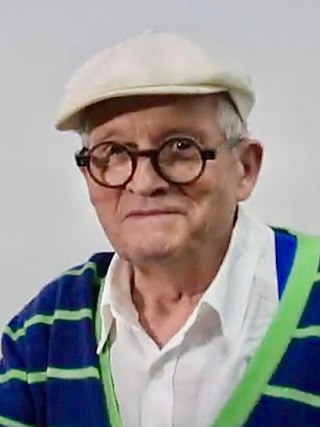
David Hockney is an English painter, draftsman, printmaker, stage designer, and photographer. As an important contributor to the pop art movement of the 1960s, he is considered one of the most influential British artists of the 20th century.
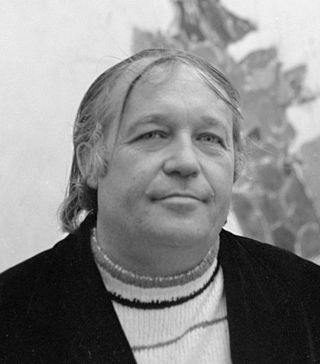
Samuel Lewis Francis was an American painter and printmaker.
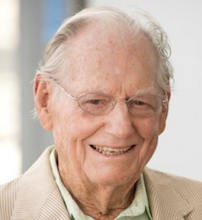
Morton Wayne Thiebaud was an American painter known for his colorful works depicting commonplace objects—pies, lipsticks, paint cans, ice cream cones, pastries, and hot dogs—as well as for his landscapes and figure paintings. Thiebaud is associated with the pop art movement because of his interest in objects of mass culture, although his early works, executed during the fifties and sixties, slightly predate the works of the classic pop artists. Thiebaud used heavy pigment and exaggerated colors to depict his subjects, and the well-defined shadows characteristic of advertisements are almost always included in his work.

Robert W. Irwin is an American installation artist who has explored perception and the conditional in art, often through site-specific, architectural interventions that alter the physical, sensory and temporal experience of space.

Robert L. Williams, often styled Robt. Williams, is an American painter, cartoonist, and founder of Juxtapoz Art & Culture Magazine. Williams was one of the group of artists who produced Zap Comix, along with other underground cartoonists, such as Robert Crumb, S. Clay Wilson, and Gilbert Shelton. His mix of California car culture, cinematic apocalypticism, and film noir helped to create a new genre of psychedelic imagery.

A matte painting is a painted representation of a landscape, set, or distant location that allows filmmakers to create the illusion of an environment that is not present at the filming location. Historically, matte painters and film technicians have used various techniques to combine a matte-painted image with live-action footage (compositing). At its best, depending on the skill levels of the artists and technicians, the effect is "seamless" and creates environments that would otherwise be impossible or expensive to film. In the scenes, the painting part is static while movements are integrated on it.
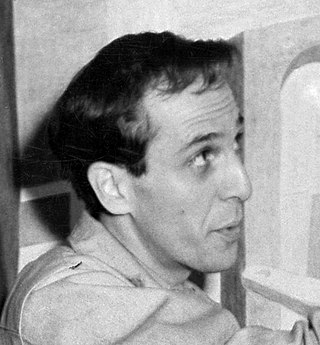
Philip Guston, was a Canadian American painter, printmaker, muralist and draftsman. Early in his five decade career, muralist David Siquieros described him as one of "the most promising painters in either the US or Mexico," in reference to his antifascist fresco The Struggle Against Terror, which "includes the hooded figures that became a lifelong symbol of bigotry for the artist." "Guston worked in a number of artistic modes, from Renaissance-inspired figuration to formally accomplished abstraction," and is now regarded one of the "most important, powerful, and influential American painters of the last 100 years." He also frequently depicted racism, antisemitism, fascism and American identity, as well as, especially in his later most cartoonish and mocking work, the banality of evil. In 2013, Guston's painting To Fellini set an auction record at Christie's when it sold for $25.8 million.

Kenny Scharf is an American painter known for his participation in New York City's interdisciplinary East Village art scene during the 1980s, alongside Jean-Michel Basquiat and Keith Haring. Scharf's do-it-yourself practice spanned painting, sculpture, fashion, video, performance art, and street art. Growing up in post-World War II Southern California, Scharf was fascinated by television and the futuristic promise of modern design. His works often includes pop culture icons, such as the Flintstones and the Jetsons, or caricatures of middle-class Americans in an apocalyptic science fiction setting.
Allan D'Arcangelo was an American artist and printmaker, best known for his paintings of highways and road signs that border on pop art and minimalism, precisionism and hard-edge painting, and also surrealism. His subject matter is distinctly American and evokes, at times, a cautious outlook on the future of this country.
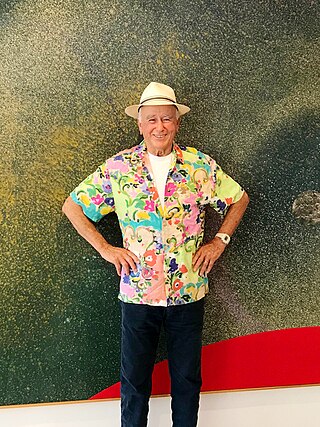
Billy Al Bengston was an American visual artist and sculptor who lived and worked in Venice, California, and Honolulu, Hawaii. Bengston was probably best known for work he created that reflected California's "Kustom" car and motorcycle culture. He pioneered the use of sprayed layers of automobile lacquer in fine art and often used colors that were psychedelic and shapes that were mandala-like. ARTnews referred to Bengston as a "giant of Los Angeles's postwar art scene."
Harrison Ellenshaw is an American matte painter, following his British father Peter Ellenshaw. He started his career at Walt Disney Studios. He later joined George Lucas's effects studio Industrial Light and Magic (ILM), where he produced many of the matte visual effects backgrounds for the films Star Wars (1977) and The Empire Strikes Back (1980). He then returned to Disney and worked on the 1979 film The Black Hole, for which he and his father were nominated for an Academy Award for their work. He also worked on The Watcher in the Woods (1980), and Tron (1982), for which he was Visual Effects Supervisor, and Dick Tracy (1990). He eventually headed Disney Studio's effects department, Buena Vista Visual Effects (BVVE).

Craig Barron is an American visual effects artist and creative director at Magnopus, a media company that produces visual development and virtual production services for motion pictures, television, museums and multimedia platforms.
Bill George is a visual effects supervisor who is known for his work for Industrial Light & Magic on, amongst others, the Star Trek franchise.
John Button was an American artist, well known for his city-scapes. Educated at the University of California, Berkeley then moved to New York City in the early 1950s. He became friends with Fairfield Porter and Frank O'Hara and assumed his part in the New York School of Painters and Poets.
Jan Marinus Domela was a Dutch-born American artist and illustrator.
Christopher Wool is an American artist. Since the 1980s, Wool's art has incorporated issues surrounding post-conceptual ideas. He lives and works in New York City and Marfa, Texas, together with his wife and fellow painter Charline von Heyl.

John Dwyer McLaughlin was an American abstract painter. Based primarily in California, he was a pioneer in minimalism and hard-edge painting. Considered one of the most significant Californian postwar artists, McLaughlin painted a focused body of geometric works that are completely devoid of any connection to everyday experience and objects, inspired by the Japanese notion of the void. He aimed to create paintings devoid of any object hood including but not limited to a gestures, representations and figuration. This led him to the rectangle. Leveraging a technique of layering rectangular bars on adjacent planes, McLaughlin creates works that provoke introspection and, consequently, a greater understanding of one's relationship to nature.

Peter Plagens is an American artist, art critic, and novelist based in New York City. He is most widely known for his longstanding contributions to Artforum and Newsweek, and for what critics have called a remarkably consistent, five-decade-long body of abstract formalist painting. Plagens has written three books on art, Bruce Nauman: The True Artist (2014), Moonlight Blues: An Artist's Art Criticism (1986) and Sunshine Muse: Modern Art on the West Coast, 1945-70 (1974), and two novels, The Art Critic (2008) and Time for Robo (1999). He has been awarded major fellowships for both his painting and his writing. Plagens's work has been featured in surveys at the Museum of Modern Art, Los Angeles County Museum of Art (LACMA), Whitney Museum, and PS1, and in solo exhibitions at the Hirshhorn Museum and Las Vegas Art Museum. In 2004, the USC Fisher Gallery organized and held a 30-year traveling retrospective of his work. Critics have contrasted the purely visual dialogue his art creates—often generating more questions than answers—with the directness of his writing; they also contend that the visibility of his bylines as a critic has sometimes overshadowed his artmaking—unduly. Los Angeles Times critic David Pagel described Plagens's painting as a "fusion of high-flying refinement and everyday awkwardness" with an intellectual savvy, disdain for snobbery and ungainliness he likened to Willem de Kooning's work. Reviewing Plagens's 2018 exhibition, New York Times critic Roberta Smith called the show an "eye-teasing sandwich of contrasting formalist strategies," the hard-won result of a decade of focused experimentation.

Charles Christopher Hill is an American artist and printmaker. Hill lives and works in Los Angeles, California and was married to the late Victoria Blyth Hill, an art conservator. He has been artist in residence at Cité International Des Arts, Paris, France, at Chateau de La Napoule, La Napoule, France and at Eklisia, Gümüslük, Turkey (1994).
Michael Pangrazio is an American art director in the feature film industry best known for his matte painting work on Raiders of the Lost Ark and The Empire Strikes Back. As traditional and digital matte artist, he created some of the most famous matte paintings in movie history. His best known painting is the Raiders of the Lost Ark warehouse interior set-extension at the end of the movie.
References
- 1 2 3 4 5 6 7 8 Chell, David (1987). Moviemakers at Work. Redmond, Washington: Microsoft Press. pp. 293–294. ISBN 1-55615-037-7.
- 1 2 3 "Christopher L. Evans '72" (PDF). Bay Shore High School Alumni Association. 2004. Archived (PDF) from the original on 2022-02-26. Retrieved 2022-02-26.
- 1 2 3 4 5 6 7 8 9 Del Castillo, Priscilla (2002-01-01). "A Talent Without Limits". Christian Science Sentinel. Retrieved 2022-02-26.
- 1 2 3 4 5 6 Parks, John A. (July 2008). "Golden Distances: The Paintings of Christopher Evans". American Artist. pp. 29–34.
- 1 2 3 "Fischbach Gallery website". Archived from the original on 2011-07-11. Retrieved 2010-07-11.
- 1 2 3 "Bio / Resume". Christopher Leith Evans. Retrieved 2022-02-26.
- ↑ Crane, Tricia (1980-09-12). "An Artist's Eye View of the City of Angels". Valley News.
- ↑ Howell, Betje (1980-10-04). "Los Angeles, as viewed by artists". Weekend Outlook. Santa Monica Evening.
- ↑ Wilson, William (1980-09-21). "Muni's L.A. Show: A City on Wheels, But Few Drivers". Calendar. The Los Angeles Times. p. 94.
- ↑ Knight, Christopher (1980-09-21). "Art That Tries to Examine Elusive L.A.". Los Angeles Herald Examiner. p. E7.
- 1 2 "Nominees/Winners | Television Academy". Emmys.com. Retrieved July 5, 2017.
- 1 2 "Chris Evans". Television Academy. Retrieved 2021-08-18.
- ↑ Kay, Alfred (1987-07-25). "'Sho', 90 minutes of bizarre theater in San Francisco". Contra Costa Times.
- 1 2 Hertelendy, Paul (1987-07-24). "It's state of the art gentle on the mind". San Jose Mercury News.
- ↑ Durant, Mark (1987-08-05). "Metamorphosis as Metaphor". ArtWeek. Vol. 18, no. 27.
- ↑ Diaz, Jesus. "How the original Star Wars trilogy fooled everyone with matte paintings," Sploid, January 19, 2015. Retrieved December 29, 2015.
- 1 2 Goodman, Peter (2004-08-15). "'E.T.' scene painter calls Bay Shore home". On the Isle. Newsday. pp. C29.
- 1 2 Smith, Roberta (2002-09-06). "Art Review; From Photos to Relics, Remembering the Unforgettable". The New York Times. ISSN 0362-4331 . Retrieved 2022-02-26.
- 1 2 Sowore, Omoyele (March 2005). "Artist Tackles Corporate Greed, Global Oppression From His New York Garage". The Guardian.
- 1 2 "Meet Supply Chain Portraits artist Christopher Evans". Sonoma State University. 2018-04-13. Archived from the original on 2020-08-13. Retrieved 2022-02-26.
- ↑ Wallach, Beth (2005-04-28). "Tales of Torture on a Spring Day". Rockville Center Herald.
- ↑ "Art Show: The Power of 10". Petaluma Argus-Courier. 2018-01-18. Retrieved 2022-02-26.